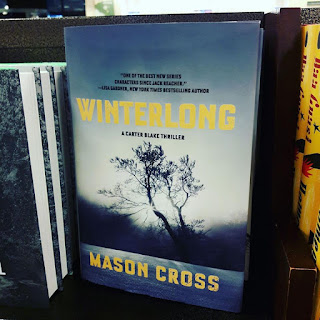I've always loved New York. Even before I visited for the first time a few years ago, I loved the idea of it.
Before I made the trip in person, I got to know the city through countless movies and books, and in particular from the wonderfully geographically-specific parts of town where Spider-Man or the X-Men would battle their enemies. I saw the city through many eyes before my own, from Holden Caulfield to Nick Carraway to Jerry the mouse. I love big cities in general, but NYC in particular.
So it was particularly enjoyable to make my first trip to the Big Apple as an author, even for a few short days. Even better - we were able to secure babysitting, so my wife Laura was able to tag along, which was great as we don't get to spend much time together, just the two of us.
Things started out well with a fairly smooth flight (I'm not the world's biggest fan of air travel), with a stopover at Reykjavik. I got some writing done and finally got to see Mad Max: Fury Road, which I enjoyed, although not quite as much as The Road Warrior.
 |
| Somewhere cold |
Arriving at JFK, we took the Long Island Rail Road to Penn Station, getting into the city around 7pm local, which was midnight by my body clock. As it was a brief visit, I did what I always do, which is stay on GMT - why not take advantage of the fact you’re in a place that bills itself as the city that never sleeps? In truth, I’m not a morning person anyway, so a five hour time difference puts me in the sweet spot. We decided to walk the twenty-four blocks north to the hotel, soaking up the sights and the sounds.
 |
| Always a nice welcoming view |
After breakfast the next morning, we visited the Barnes & Noble on 5th Avenue and I got to see one of my books in an American bookstore for the first time.
Winterlong was really well displayed as a new release, too.
After that, I visited the nearby New York Public Library and wrote some of the new book in the beautiful Rose Main Reading Room. I make a point of writing in interesting places whenever I can. I wrote part of a short story in the British Library last year, so it was nice to continue the tradition.
We headed east to drop in on Grand Central Station, which plays an important part in Winterlong, and admired the Chrysler and MetLife buildings on the way in. I really like distinctiveness of the former Pan Am building, even though it isn't held in the same regard as some of the more classically beautiful towers like its neighbour.
After getting dinner in a fantastic steak place, Laura opted to stay in the hotel with a book, and I took a walk up to Central Park and the Upper East Side, then headed all the way out to the East River and saw the Queensboro bridge in the fog. I love walking in cities, particularly big ones like NYC or London or Paris. It's absolutely the best way to absorb their unique characters: pounding the sidewalks and looking down the dark alleys, passing the doormen of upscale apartment buildings as they stand to attention beneath heated canopies.
Day two started out with a trip to the Top of the Rock. I had ticked off the Empire State Building on my first trip to the city, but this lived up to the hype of being a better view, since it actually includes the Empire State Building. From seventy floor up, I was struck again by what an incredible city this is; the towers stretching out to the tip of the island, now and forever a work in progress.
After a stroll in Central Park, I took the subway down to Chambers Street in time for my appointment at the world-famous
Mysterious Bookshop, where I signed a stack of copies of
Winterlong, which was a dream come true. The shop would have been worth the trip without that: it's a crime fiction fan's dream. I picked up some books, including a vintage short story collection by John D MacDonald - one of my big influences.
 |
| Serious author face |
After the Mysterious Bookshop, we met up for dinner with Iris and Jessica of Pegasus Books, my US publisher and we had a great evening at an Italian restaurant in Tribeca talking about books and big cities and life in general. It was a pleasant night for a walk from the subway station to the hotel, but the news was saying a change in the weather was on its way.
Winterlong climaxes with a blizzard hitting New York, so appropriately, my last day in town did too.
 |
| 6th Avenue Freeze Out |
This was a big one; big enough for them to take the drastic step of closing the schools. Watching the news, it was comforting to see that Americans freak out about the weather just as much as Brits do. I started to get a little worried about delays, but by the evening things had calmed down.
By the time we made it back to the UK, Winterlong was published all over again, this time in paperback under its British title of The Time to Kill, and I signed some copies in Waterstones. It's always good to come back home, but I'm already looking forward to the next time I'm in New York.








































